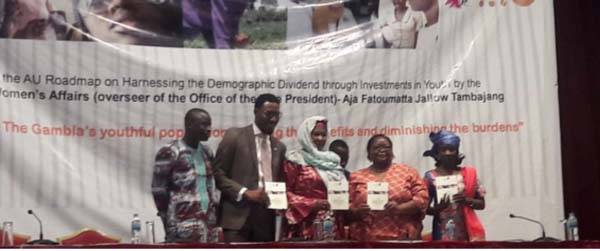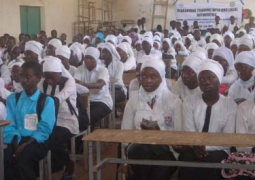
The
United Nations Population Fund (UNFPA), The Gambia Government and partners on
Friday launched the African Union Road Map on Harnessing Demographic Dividend
through investment in youth at the Kairaba Beach Hotel.
The
launching was presided over by the Women’s Affairs Minister, who is also
oversees the Vice Presidency.
The
launching brought together young people and youth organisations under the
National Youth Council under the theme: “Capitalising on the Gambia’s Youthful
Population: Reaping the benefits and diminishing the burden.”
In
her launching statement, the Women’s Affairs Minister who also doubles as the
overseer the office of the Vice President, Aja Fatoumatta Jallow Tambajang,
said as was being experienced in most African countries, The Gambia has over
the years witnessed a rapid rate of population growth.
The
current population is projected at 1.9 million and is expected to grow at an
average annual rate of 3.1 per cent, she said.
She
said the most important statistic may be that 42.7 per cent and 64 per cent of
the population are below the ages of 15 and 24 years respectively.
The
youthful nature of the population is indicative of the population continuing to
grow at a rapid rate in the foreseeable future, she stated, emphasing that the
youthful age structure of the population has both social and economic
ramifications.
“Government
is aware of the disproportionate effect of unemployment among young people and
some of the negative social consequences,” she added.
For
her part, Perpetua Katepa Kalala, the United Nations Resident Coordinator, said
the United Nations systems in The Gambia stand committed to supporting the
Government in its development agenda set out in the draft National Development
Plan.
“UN has multilateral, universal and neutral
characteristics with ability to respond to development needs in a flexible
manner that ensures effective and efficient partnerships to support member
states.”
She
assured: “We stand ready to support the different global and regional
frameworks for action like the Africa Union Agenda 2063, and the New
Partnership for Africa’s Development (NEPAD).”
In The Gambia, she said, all the different
agencies and programmes have a specific focus within their different mandates
to meet the above commitment.
Also
speaking at the launching, Kunle Adeniyi UNFPA Gambia country office Chief of
Operation, said the United Nations Population Fund (UNFPA), as well as other
United Nations partners and development agencies agreed to, among other things
to develop the road map.
The
roadmap identifies key deliverables, milestones and actions to expedite the
implementation of the continental initiative on Demographic Dividend for
Africa, he divulged.
According
to him, the roadmap was developed through a consultative process of
stakeholders and was conceived bearing in mind the urgent necessity to
transform the potential of Africa’s large youth population into a demographic
dividend, through proper management and the right investments.
He
said a large cohort of youth offers a potentially rich resource for developing
countries as more people should naturally be available to work, but only if
that resource could be effectively harnessed.
He said there are two key pre-conditions to
realising the demographic dividend. The first was to create a dynamic economy
that would serve as an engine of job creation and provide productive employment
for large cohorts of youth.
The
second pre-condition was a strong commitment of resources to the health and
education of youth so that they are prepared to compete in a global economy.
Henry
Gomez, Minister of Youth and Sports, speaking on the occasion, stressed that
the bulging population of young people in The Gambia poses development
challenges but could also be transformed into an opportunity for effective
contribution to national development.
He
emphasised that without the relevant investments in youth to realise their full
potentials, young people could easily be exposed to vices such as forced
migration, radicalisation and violent extremism.
“We
have witnessed the massive migration of young people from the country to Europe
using perilous routes and many young lives have already been lost in the
process of trying to reach Europe.”
The Gambia, he said, could reap the benefits
of a bulging young population by investing in youth empowerment programmes.
Read Other Articles In Article (Archive)
Leigh & Brix Valerenga move to 3rd in Norway
Jun 8, 2010, 2:52 PM
KAC presents cleansing materials to Barra military camp
Sep 5, 2014, 10:12 AM



